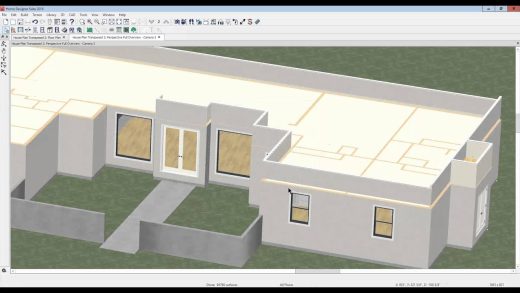Simple Rules for a Great Roofing Website
The Importance of a Great Website for Your Roofing Business
As a roofing business owner, it’s crucial to have an effective online presence. A great website can help you attract new customers and showcase your services, while also establishing your credibility in the industry.
A poorly designed website can be a major turnoff for potential clients. It may give the impression that your business is not professional or trustworthy. On the other hand, a well-designed website can instill confidence in visitors and encourage them to contact you for their roofing needs.
Your website is often the first point of contact between your business and potential customers. It should be able to provide all necessary information about what you offer at a glance. This means showcasing your services clearly with concise descriptions, high-quality images or videos, and easy-to-find pricing information.
In addition to showcasing your services, having clear calls-to-action such as “Contact Us” buttons are important for users wanting more information on these offerings.
Rule 1: Understand Your Audience
Understanding your audience is the cornerstone of creating a successful roofing website. To create an effective website, it’s vital to know who your target audience is and what they’re looking for when visiting your site.
The first step in understanding your audience is to research their needs and preferences. You can start by analyzing data from your past customers or conducting surveys and interviews with potential clients. This can help you identify the pain points that drive people to seek out a roofing company, as well as any common questions or concerns they may have.
Once you understand your target audience, it’s important to tailor the content on your website to meet their specific needs. For example, if many of your clients are concerned about finding a reliable roofer at an affordable price, make sure that information prominently displayed on the homepage.
Furthermore, consider how different segments within your target audience might respond differently to various aspects of web design and messaging. For instance, younger homeowners may prefer more modern fonts and images while older homeowners might be drawn towards more traditional designs.
By understanding what motivates potential clients when searching for roofing services online and catering specifically to those motivations through design choices such as color schemes or font types – you’ll be able to increase conversions significantly over time.
Rule 2: Create a Professional and Clean Design
Creating a professional and clean design is crucial for any roofing website. Visual appeal plays a significant role in making an excellent first impression on potential customers. It’s essential to use colors that complement your brand message and fonts that are easy to read.
A cluttered website can be overwhelming, so it’s important to keep the design simple yet effective. A well-designed website will draw visitors’ attention to your services rather than distracting them with unnecessary elements. Be sure to prioritize essential information such as contact details and services offered.
Using high-quality images of completed projects or videos demonstrating your roofing techniques can also help showcase your expertise in the industry.
The layout of the website should be intuitive with clear navigation menus and site maps, allowing visitors to find what they need quickly. An organized structure not only helps users navigate through the website but also improves search engine optimization (SEO).
Creating a professional and clean design is integral for converting visitors into customers on a roofing business’s website. By prioritizing visual appeal, showcasing services clearly, using intuitive site structure, businesses can ensure their websites stand out among competitors in the crowded online space.
Importance of Visual Appeal
When it comes to creating a roofing website, the visual appeal is of utmost importance. It’s no secret that people are drawn to attractive designs and visuals. That’s why having an aesthetically pleasing website can significantly increase your chances of conversion.
Using colors and fonts effectively is crucial in achieving a visually appealing design. Colors play a significant role in influencing consumer behavior, so choose your color palette wisely. Stick with colors that represent trust, reliability, and professionalism – such as blues and grays – while avoiding bright or garish shades.
In addition to color selection, choosing the right font is also essential for visual appeal. Make sure you use easy-to-read fonts like sans-serif; this will make your site look professional while ensuring visitors don’t struggle when reading content.
Another key element of creating an appealing design is using images strategically throughout the site. Be selective when choosing imagery; opt for high-quality photos or videos that showcase your workmanship instead of generic stock photos.
Ultimately, investing time into making sure your website looks great can pay off big time by attracting more customers to your roofing business!
Using Colors and Fonts Effectively
Colors and fonts are two key elements that can make or break your roofing website’s design. When chosen correctly, they can enhance the visual appeal of your site, evoke emotions in visitors, and ultimately improve your website conversion rates.
When selecting colors for your roofing website, it’s essential to keep in mind the psychology behind each hue. For instance, blue is often associated with trustworthiness and professionalism, while green signifies growth and vitality. Use this knowledge to choose color schemes that best represent your brand values and resonate with your target audience.
In terms of fonts, simplicity is key. Stick to easy-to-read typefaces such as Arial or Helvetica for body text. For headings or titles on pages like “Contact Us” or “Services,” consider using more stylish options such as Roboto Condensed or Montserrat Bold.
Additionally, use font size effectively by ensuring that important information stands out without overwhelming other content on the page. A mix of bolded words and larger font sizes will help achieve this balance while maintaining a professional look.
Both colors and fonts are critical components of an effective roofing website design strategy. Keep them simple but impactful to create a lasting impression on potential customers visiting your site!
Rule 3: Showcase Your Services Clearly
When potential customers come to your roofing website, they want to know exactly what services you offer and how those services can benefit them. Therefore, it’s crucial that you showcase your services clearly on your website.
One effective way to do this is by creating a detailed services page that outlines each service you offer along with a brief description of what it entails. Use clear and concise language so visitors can easily understand the scope of work involved in each service.
In addition to written descriptions, consider using images or videos to demonstrate your work. This helps customers visualize the quality of work you provide and gives them an idea of what they can expect when working with your company.
Another important aspect is making sure all information about pricing for these services are clearly laid out on the page as well. People need to know all associated costs before deciding whether or not they want to hire someone for their project.
By showcasing your services clearly, potential clients will have a better understanding of what you offer, which ultimately increases the chances of converting them into paying customers who trust in your expertise and skill set.
Creating a Detailed Services Page
When it comes to a roofing website, the services page is one of the most important pages. This page gives potential customers an idea of what your business offers and why they should choose you over competitors. Creating a detailed services page can make all the difference in terms of conversions.
Firstly, it’s essential to list all your roofing services clearly on this page. Don’t leave anything out or assume that people know what you offer because they might not. It’s always better to provide comprehensive information about every service, no matter how basic.
Secondly, use images and videos as much as possible to show what each service entails. People are more likely to engage with visual content than just plain text descriptions.
Additionally, try categorizing your services based on their type or specificity so that visitors can easily find exactly what they’re looking for without having to scroll through too many irrelevant details.
Include any special deals or promotions related specifically to these services at the end of each description – this may just be enough for visitors who were previously unsure about using your company’s services!
Using Images and Videos for Demonstration
When it comes to showcasing your roofing services on your website, images and videos can be a powerful tool. Rather than just describing what you offer in text, visual aids can help potential customers better understand the quality of your work.
One effective way to use images is by including before-and-after photos of completed roofing projects. This not only shows off the quality of your work but also gives potential customers an idea of what they can expect if they hire you.
In addition to photos, consider creating videos that showcase some of your roofing services in action. For example, create a time-lapse video showing the process of installing a new roof or repairing damaged shingles. These types of videos give visitors a behind-the-scenes look at how you operate and can help build trust with potential customers.
It’s important to make sure all images and videos are high-quality and professionally produced. Poorly shot or blurry visuals may do more harm than good when trying to impress potential clients.
Incorporating visual elements into your website through images and videos is an effective way to demonstrate the quality of your roofing services and make a lasting impression on visitors.
Rule 4: Make Your Website Easy to Navigate
Making your roofing website easy to navigate is crucial for ensuring a great user experience. An intuitive site structure allows visitors to find what they need quickly and easily, which can lead to higher website conversion rates.
One of the most important aspects of creating an effective navigation system is designing a clear and concise menu. Your menu should be organized logically, with each item labeled in a way that accurately reflects its content. Avoid using overly complex or technical language that may confuse visitors.
Another key component of easy navigation is providing users with an intuitive site map. A well-designed site map can help visitors quickly locate specific pages on your website without having to click through multiple menus or search results.
In addition to these basic features, it’s also important to consider including additional tools such as dropdown menus and search bars. These can help further streamline the navigation process by allowing users to quickly access relevant information from any page on your website.
Taking the time to create a user-friendly navigation system will go a long way towards improving the overall effectiveness of your roofing website. By making it easier for potential clients or customers to find what they need, you’ll be able to increase engagement and drive more conversions over time.
Importance of Intuitive Site Structure
The structure of your roofing website is crucial to its success. A disorganized and confusing layout can lead potential customers to leave before they’ve even had a chance to see what you offer. That’s why it’s so important to create an intuitive site structure that makes it easy for visitors to find what they’re looking for.
One way to accomplish this is by organizing your content into logical categories. You should have a clear navigation menu at the top of your page, which clearly displays the different sections of your website. This helps users understand where they are on the site and how they can access other parts of it.
Another important aspect of intuitive site structure is using headings and subheadings effectively. These help break up blocks of text, making them easier to read, while also guiding visitors through the various sections of each page. Be sure to use descriptive titles that accurately summarize what each section covers so users know exactly what information they’ll find there.
Make sure your pages load quickly and efficiently – nobody wants to wait around for slow-loading pages! Optimize images and videos as much as possible without sacrificing quality, use caching plugins if necessary, and minimize unnecessary scripts or code snippets wherever possible.
By creating an intuitive site structure with clear navigation menus, concise headings/subheadings and optimized loading times you will be able increase both user engagement & conversions on your roofing website!
Creating an Effective Menu and Site Map
Creating an effective menu and site map is crucial for a great roofing website. It provides users with easy access to all the pages on your website, allowing them to quickly find what they need. A well-organized menu and site map can make your website user-friendly and increase conversions.
The first step in creating an effective menu is to prioritize your pages based on their importance. Place the most important pages, such as services or contact page, at the top of the list where they are easily accessible. Use clear and concise labels for each item in the menu that accurately describe its content.
An intuitive site structure allows you to group related pages together under relevant headings in your main navigation bar, making it easier for users to navigate through your website without getting lost or confused.
In addition, using submenus can help reduce clutter by breaking down large categories into smaller ones that are easier to manage. This strategy will also allow users to easily access related information without having to search multiple pages.
Your site map should be a complete overview of all of your webpages organized by section or category with links leading directly from one page/article/category/section/etc…to another within those same sections/categories/topics/etc…
A well-designed menu and site map can greatly enhance user experience while visiting your roofing business’s website!
Rule 5: Include Clear Calls to Action
When it comes to designing a great roofing website, including clear calls to action is crucial. A call to action (CTA) refers to any element on a webpage that prompts visitors to take an immediate and specific action, such as “Schedule Your Free Estimate” or “Call Us Now.”
To create effective CTAs, it’s important to understand your audience and what motivates them. Are they looking for quick service? Do they want high-quality workmanship? Whatever their needs may be, make sure your CTAs address those pain points.
In addition, your CTAs should be prominently displayed on every page of your website. Use contrasting colors or bold fonts to make them stand out from other elements on the page.
Another tip for creating effective CTAs is using urgent language. For example, instead of saying “Contact Us,” say “Get in Touch Today!” This creates a sense of urgency and encourages visitors to act quickly.
Regularly test and analyze the performance of your CTAs. Experiment with different wording or placement until you find what works best for converting visitors into customers.
By following these tips, you can effectively use calls to action on your roofing website and increase conversions for your business.
Rule 6: Showcase Testimonials and Reviews
One of the best ways to establish credibility and trust with potential customers is by showcasing testimonials and reviews from your past clients. When people are searching for a roofing business, they want to know that they can rely on you to provide quality work and exceptional customer service.
Including positive feedback on your website shows that you have a proven track record of delivering excellent results, which can make all the difference in converting visitors into paying customers.
It’s important to choose testimonials that are relevant and specific to the services your roofing business provides. For example, if you specialize in repairing leaky roofs, feature testimonials from satisfied customers who had similar issues with their roofs.
When displaying reviews or testimonials on your website, it’s essential to be transparent about where they came from. Include the client’s name, photo (if possible), and any other identifying information that adds legitimacy.
Don’t forget to regularly update your testimonial section as new feedback comes in. This not only keeps things fresh but also demonstrates ongoing customer satisfaction with your services.
Rule 7: Ensure Your Website is Mobile-Friendly
In today’s world, where people are always on-the-go and rely heavily on mobile devices for browsing the internet, having a mobile-friendly website is crucial. The same goes for roofing businesses that are looking to attract new clients online.
A mobile-friendly website ensures that your potential customers can access your content from any device without facing issues like slow loading times or distorted images. It also helps in improving user experience and engagement, ultimately leading to more conversions.
To make sure that your roofing website is mobile-friendly, you need to ensure that it has a responsive design. This means that the site will automatically adjust its layout according to the screen size of the device being used.
Another important aspect of having a mobile-friendly website is ensuring that all clickable elements such as buttons and links are easily accessible via touch-screen navigation. A good practice is to have larger font sizes and clear call-to-actions (CTAs) so visitors can quickly find what they’re looking for.
By implementing Rule 7 into your roofing business’ web design strategy, you’ll be able to cater effectively towards those who prefer accessing websites through their smartphones or tablets while still offering an enjoyable browsing experience regardless of which platform they use.
Rule 8: Implement Search Engine Optimization (SEO)
Search engine optimization (SEO) is the process of optimizing your website to rank higher on search engines like Google. This is important because most people use search engines to find local businesses, including roofing companies.
To implement SEO for your roofing website, start by doing keyword research. Identify the keywords and phrases that potential customers are using to search for services like yours. Then, make sure those keywords are included in your website’s content, meta descriptions, titles and headers.
Next, focus on creating high-quality content that includes those keywords naturally. Blogging about industry trends and providing informative articles can help establish you as an authority in the roofing business while also improving your website’s visibility on search engines.
Another important aspect of SEO is link-building which means getting other reputable websites in your area to link back to yours. Consider reaching out to local bloggers or home service directories for partnership opportunities.
Regularly monitor and analyze your website traffic data through tools like Google Analytics so you can adjust your SEO strategy based on what’s working best. Remember that implementing strong SEO practices will not only improve organic traffic but it will also increase chances of conversion rates from visitors into potential leads!
Rule 9: Regularly Update Your Content
Updating your website’s content is crucial not just for search engine optimization but also for keeping your audience engaged. Regularly updating your content ensures that visitors to your site are seeing fresh, relevant information.
One of the best ways to update your website content is through a blog. A blog allows you to create timely and informative articles on various topics related to roofing. These articles can be about anything from tips and tricks for maintaining a roof, current trends in roofing materials, or answering frequently asked questions.
In addition to blogs, it’s important to keep other pages on your website updated as well. This includes services pages and testimonials/reviews sections. As you add new services or receive positive reviews from customers, make sure they are reflected on your website.
Not only does regularly updating your website improve user experience and SEO, it also shows potential clients that you care about providing them with up-to-date information and quality service.
Rule 10: Provide Easy Ways to Contact You
Making it easy for potential customers to contact your roofing business is critical. If they can’t find a way to reach out, they will move on to the next company that provides that option. Therefore, you need to have multiple ways for them to get in touch with you.
Firstly, include a clear and visible “Contact Us” page on your website’s main menu. This page should provide essential information such as your phone number, email address, physical address, and even links to social media profiles where applicable.
Secondly, consider including an online contact form on various pages of your website so visitors can quickly send you their details or questions through the site without having to open their email client.
Thirdly, make sure that any phone numbers or clickable buttons are prominent and always working correctly. Ensure every link is correct so users don’t end up frustrated by broken links leading nowhere.
Lastly but most importantly: be responsive! Prompt responses show prospective clients that they matter and could lead towards more conversions from visits into paying customers within no time!
Conclusion
In today’s digital age, having a great website is crucial for any business, including roofing companies. A well-designed and optimized website can help you attract potential customers, showcase your services and build trust with your audience.
By following the simple rules outlined in this article, such as understanding your audience, creating a professional design, showcasing your services clearly and implementing SEO strategies – you can create a roofing website that not only looks great but also converts visitors into paying customers.
Remember to regularly update your content and ensure that it’s mobile-friendly so that you don’t miss out on potential leads. By providing easy ways for visitors to contact you and showcasing positive reviews from satisfied customers – you’re sure to establish yourself as the go-to roofer in town.
So what are you waiting for? Use these simple rules to improve your roofing website today!



